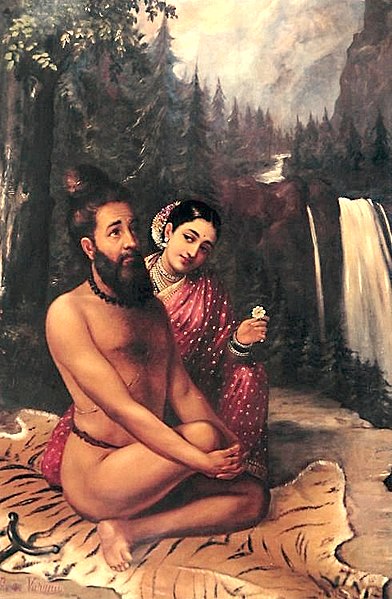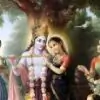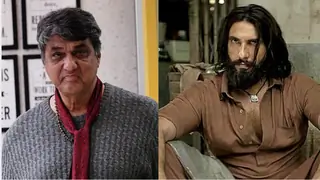"O king, this feast that you have partaken with your kinsmen, has been provided by my calf Nandini (sometimes referred as Sabala), who was gifted to me by Indra. You must know that she is the daughter of Indra's cow Kamadhenu. She provides me with everything I need."
Kaushika was filled with wonder when he heard this. He began to think that possessing this cow would mean a lot to him; after all, the sage did not have to provide food and sustenance for a large army everyday. He expressed a desire to the sage for obtaining Nandini from him. Vashista was polite, but steadfast in his refusal. He would not be tempted by the offer of untold wealth that was made by Kaushika, for after all who can set a price on a cow, which can readily yield all the riches in the world.
The king grew exceedingly angry. He insulted the Brahmarishi with harsh words, and ordered his soldiers to seize the cow, and drive it to his kingdom. Nandini was the daughter of Kamdhenu and hence she forcefully protested against the soldiers. Using her powers, she saved the life of Vashista.
Alternative Version :-
Vashista destroys vishvamitra's entire army by the simple use of his great mystic and spiritual powers, breathing the Aum syllable. Vashista also thus kills one hundred of vishvamitra's sons, while restoring his hermitage's beauty and life.
Vishvamitra then undertakes a tapasya for several years to please Shiva, who bestows upon him the knowledge of celestial weaponry. He proudly goes to Vashista's ashram again, and uses all kinds of powerful weapons to destroy Vashista and his hermitage. He succeeds in the latter but not in the former.
An enraged Vashista brings out his brahmadanda, a wooden stick imbued with the power of Brahma. It consumes Vishvamitra's most powerful weapons, including the brahmastra. Vashista then attempts to attack vishvamitra, but his anger is allayed by the Devas. Vishvamitra is left humiliated while Vashista restores his hermitage.
TAPASYA :-
This incident made a deep impression on the King. He realized that the power obtained by penances was far greater than mere physical might. He renounced his kingdom and began his quest to become a greater rishi than Vashista. He took on the nameVishvamitra. It is very interesting to see all the challenges that Viswamitra faced in his life to become a Brahmarishi, before eventually giving up the greed to possess the cow. After many trials and undergoing many austerities, Vishvamitra at last obtained the title of Brahmarishi from Vashista himself. During this time he had a daughter named Shakuntala(who appears in the Mahabharata) with Menaka, an apsara in the court of Indra. Son of Shakuntala became a great emperor. He came to be known as Emperor Bharata, in whose name the land of India got its name Bharatha.
Alternative Version :-
Kaushika seeks to attain the same spiritual power as Vashista, to become his equal, aBrahmarishi. He undertakes a fierce penance for one thousand years, after which Brahmanames him a Rajarishi, or royal sage.
After another long penance of thousand years, Brahma names him a Rishi, thus leaving his royal lineage permanently. And Brahma suggest him to take Bramharshi grade from his guru Vashista only, as he only has the power to call you as Brahmarshi.
At this point, Indra, the king of Swarga attempts to test the tapasvin by sending Menaka, an apsara to seduce him. Kaushik then lives with Menaka for 10 years. They have a baby girl Shakuntala. Kaushik becomes angry as Menaka had destroyed his years of meditation and thus he cursed her that she won't possess her beauty, of which she was proud, in next birth.
Kaushika now goes to the banks of the river Kaushiki, which is the spirit of his own sister. After many thousands of years of penance,Brahma names him maharishi, but also tells him that he hasn't become a jitendriya yet, lacking control over his passions. This is brought to light to Kaushika when he angrily curses Rambha, an apsara sent by Indra to seduce Kaushika again, to become a stone for a thousand years.
RISE TO BRAHMARISHI :-
After cursing Rambha, Kaushika goes to the highest mountain of the Himalayas to perform an even more severe tapasya for over a thousand years. He ceases to eat, and reduces his breathing to a bare minimum.
He is tested again by Indra, who comes as a poor Brahmin begging for food just as Kaushika is ready to break a fast of many years by eating some rice. Kaushika instantly gives his food away to Indra and resumes his meditation. Kaushika also finally masters his passions, refusing to be provoked by any of Indra's testing and seductive interferences.
At the penultimate culmination of a multi-thousand year journey, Kaushika's yogic power is at a peak. At this point, Brahma, at the head of the Devas led by Indra, names Kaushika aBrahmarishi, and names him Vishvamitra, or Friend of All for his unlimited compassion. He is also embraced by Vashista, and their enmity is instantly ended.
VISHWAMITRA CHARACTERISTIC :-
As a former king, and one over as vast a realm as he had been, Vishvamitra was known to retain a regal and often haughty bearing. He was known for his high temper and often cursed people in his anger, thereby depleting his yogic powers obtained by much penance. People feared his temper and prayed that their actions might not get misconstrued by the touchy sage.
However, as a former king, Vishvamitra also possessed great compassion for all beings. Having taken pity on Trishanku, he willingly exhausted all the punya he gained from his tapas, to enable him to ascend to the heavens. Following his attainment of the status of brahmarishi, he was known to use the power of his tapas to help anyone who was in need, whatever the cost to himself.
Kaushika's love of Menaka is considered to have been intense and passionate.
GAYATRI MANTRA :-
Vishvamitra is said to have found the Gayatri Mantra. It is a mantra found in the Rig, Yajur, and Sama Vedas. Gayathri is actually a "Chandas" or meter.
LEGENDS :-
Vishvamitra is featured in many legendary stories and in different works of the Sanatana dharma.
1. Trisanku :-
Another story Vishvamitra is known for is his creation of his own version of Svarga or heaven, called Trisanku Svarga.
When a proud King Trisanku asked his guru Vashista to send him to heaven in his own body, the guru responded that the body cannot ascend to heaven. King Trisanku then asked Vashista's hundred sons to send him to heaven. The sons, believing that Trisanku should not come to them after their father had refused, took outrage and cursed Trisanku to be a Chandala, or untouchable. Trisanku was transformed into a person with body smeared of ash, clothed in black and wearing iron jewelry. Since none of his subjects could recognize him, he was driven out of the kingdom.
Trisanku came across the sage Vishvamitra, however, who agreed to help him. Vishvamitra organized a great sacrifice and ritual propitiating the Devas, pleading that they accept Trisanku into heaven. Not one Deva responded. Angered, Vishvamitra used his yogic powers and ordered Trisanku to rise to heaven. Miraculously, Trisanku rose into the sky until he reached heaven, where he was pushed back down by Indra.
Enraged even more by this, Vishvamitra commenced the creation of another Universe (including another Brahma) for Trisanku. He had only completed the Universe whenBrihaspati ordered him to stop. Trisanku, however, did not fully transcend through the Trisanku Svarga created for him. He remained fixed in the sky and was transformed into aconstellation.
In the process of forming a new universe, Vishvamitra used up all the tapas he had gained from his austerities. Therefore after the Trisanku episode, Vishvamitra had to start his prayers again to attain the status of a Brahma Rishi, to equal Vashista.
2. Ambarisha's Sacrifice :-
While undertaking a penance, Kaushika helps a boy named Shunashepa who has been sold by his parents to be sacrificed atAmbarisha's yagna to please Varuna. The king's son Rohit does not want to be the one sacrificed, as was originally promised to Varuna, so young Sunashepa is taken. A devastated and terrified Sunashepa falls at the feet of Kaushika, who is deep in meditation, and begs for his help.
Kaushika teaches secret mantras to Sunashepa. The boy sings these mantras at the ceremony, is blessed by Indra and Varuna, and Harishchandra's ceremony is completed.
3. In the Ramayana :-
In the Indian epic Ramayana, Vishvamitra is the preceptor of Rama, prince of Ayodhyaand the seventh Avatar of Vishnu, and his brother Lakshmana.
Vishvamitra gives them the knowledge of theDevastras or celestial weaponry [bala and adi bala], trains them in advanced religion and guides them to kill powerful demons likeTataka, Maricha and Subahu. He also leads them to the svayamvara ceremony for princess Sita, who becomes the wife of Rama.
4. Vishwamitra in Buddhism :-
In the Buddhist Vinaya Pitaka of the Mahavagga (I.245) section the Buddha pays respect to Vishwamitra by declaring that the Veda in its true form was declared to the Vedic rishis "Atthako, Vamako, Vamadevo, Vessamitto, Yamataggi, Angiras, Bhradvjo,Vsettho, Kassapo, and Bhagu" and because that true Veda was altered by some priests he refused to pay homage to the altered version.
GOTRAS :-
There are two gotras, or lineages, bearing the name of Vishvamitra.
1. Vishwamitra Gotra :-
People belonging to the Vishvamitra Gotra consider Brahmarishi Vishvamitra as their ancestor.
There is an off-shoot of "Vishvamitra Gotra" called "Chakita Vishvamitra Gotra". Two explanations have been suggested for this off-shoot. The group is supposed to have sprung from a "surprised" reaction of Vishvamitra. The other, more likely, explanation, is that a group of descendants decided to split from the main group and started their own branch of this line.
2. Kaushiki Gotra :-
People belonging to Kaushika ( Kaushik /Kousika/Kousikasa/Koushika/Kausika) Gotra take Rajarishi Kausika as their root.
- Mithila- Nepal Terai and present Bihar's north portion
- Haryana
- Assam valley
- Odisha
- Gujarat
- Rajasthan
- Maharashtra
- Himachal Pradesh
- Karnataka
- Kerala
- Andhra Pradesh
- West Bengal
- Aathisheshan surname Bramins-Kaushik Gotram.
- Bharindwal Surname Brahmins-Kaushik Gotram
- Chevitikanti or Gandavarupu (Niyogi Brahmins - Kaushikasa Gotram)
- Ejanthakar (Bhavsar Kshatriyas from Maharashtra - Kaushik Gotram)
- Tatta (Srivaishnavaites, Andhra Pradesh (Viswamithra Gotra)
- Kappaganthu/la (Vaidika Velanadu Brahmins of Kaushika Gothra from Andhra Pradesh)
- Singhs of North Bihar(Kaushika Rajputs of Viswamitra Gotra) and U.P.
- Mittagunta (are Niyogi Brahmins of the Kaushika Gotra)
- Pavani/voruganti (are Niyogi Brahmins of the Kaushika Gotra)(AndhraPradesh Brahmins)
- Jayanthi (Vaidika Bhramins of Kaushika-sa Gotra from Andhra Pradesh)
- Katrapati (Niyogi Brahmins of Kaushika-sa Gothra from Andhra Pradesh)
- Nanduri (Niyogi Brahmins of Kaushika-sa Gothra from Andhra Pradesh)
- Basavaraju (Niyogi Brahmins of Kaushika Gothra from Andhra Pradesh)
- Vemaraju (Niyogi Brahmins of Kaushika Gothra From Andhra Pradesh)
- Yeleswarapu (Vaidika Brahmins of Kaushika-sa Gothra from Andhra Pradesh)
- Ganduri (Vaidika Velanadu Brahmins of Kaushika Gothra from Andhra Pradesh)
- Chitrapu (Niyogi Brahmins of Kaushika Gothra from Andhra Pradesh)
- Desai (some Desai of Anavil Brahmin of Gujarat are of Kaushika Gotra)
- Trivedi of Modh Brahmin belonging to Kaushika Gotra
- Dave (some Dave Audichya Brahmins of Gujarat belong to Kaushika Gotra)
- Sripada (vaidiki velnadu Brahmins of Andhra Pradesh belong to Kaushika Gotra
- Dhulipala of Andhra Brahmin belongs to Kaushika sa Gotra
- Mallela of Vaidiki Brahmins of Andhra Pradesh belongs to Kaushika Gotra
- Mitra of West Bengal belongs to Vishvamitra Gotra
- Chakrabarty (some of them)in West Bengal belongs to Ghrita Kaushik Gotra.
- Joshi of Uttrakhand belong to Kaushik Gotra.
- Iriventi (Vaidika bramhins of Vishwamitra gotra from Andhra Pradesh)
- Lakkavajhula (Vaidika Velanadu Brahmins of Vishwamitra Gothra from Andhra Pradesh)
- Velivela (Niyogi Brahmins of Vishwamitra Gothra from Andhra Pradesh)
- Velala (Madhwa Brahmins (Viswamitra) gothra of Andhrapradesh)
- Udupa (Belonging to Vishvamitra gotra from Udupi, Karnataka)

































